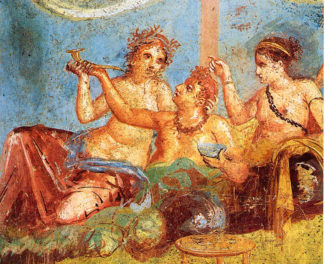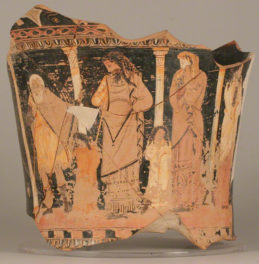
Fragment of a Fresco Panel with a Meal Preparation, A.D. 1–79, Roman. Fresco, 27 3/8 × 50 in. The J. Paul Getty Museum, Villa Collection, 79.AG.112. Digital image courtesy of Getty’s Open Content Program
Since many of us are spending more time cooking at home these days, this could be an opportune time to explore ancient culinary history by replicating a Roman-style dish. You can do this simply by looking in your pantry, refrigerator, or freezer!
Feel free to experiment with vegetables, legumes, or grains similar to those eaten in the ancient world. Onions, carrots, celery, leeks, peas, parsnips, chard, asparagus, and fennel were common and popular. Garlic and foods such as barley, farro, lentils, chickpeas, and olive oil provided the base of many dishes. Just make sure to avoid such Byzantine additions as citrus (no lemon juice allowed!) and rice (substitute barley or farro).
New World novelties like tomatoes, potatoes, peppers, and chocolate were unheard of, so many flavors we think of as Italian were not available to the ancient Romans but actually were the result of much later European trade.
An ancient collection of Roman recipes has survived under the name of Apicius (first century A.D.), but whoever had that name is not thought to have been a writer of cookbooks. Written in vulgar Latin (colloquial Latin), the Latin of the slave-cooks who made the meals, the collection is thought to have been compiled by a scribe for them to use in the kitchen.
The recipes below are inspired by those dishes and will give a good idea of how Romans ate. They are not the dishes of the gluttonous banquets infamously staged at the Imperial court, but the kind of food eaten by the families, soldiers, and commercial populace of the city’s insula, or apartment neighborhoods.
Supplemented by exotic imports like cinnamon and nutmeg that reached Rome by means of active trading routes to the East, recipes such as these became staples of daily meals and could also play a role in more elaborate feast-day preparations. We have used Apicius as a jumping-off point for creating our own delicious recipes—Roman-style!
Lentil Stew
Featured in the Bible, lentils are the oldest known legume crop and come in many types and sizes. Add lentils and any broth variety to a basic olive oil sauté of vegetables such as onions, carrots, celery, and chard for an authentic Roman way to use up the leftover ingredients in your pantry.
Ingredients
2 tablespoons olive oil
1 cup red lentils (green or brown lentils work well here, too, but may have different cooking times)
½ cup carrots, diced
¼ cup onion, finely chopped
¼ cup celery, chopped
1 clove garlic, crushed
½ teaspoon salt
3 cups vegetable broth
1 bay leaf
¼ cup fresh parsley leaves, chopped, for garnish
Procedure
- Heat olive oil in saucepan over medium heat.
- Add chopped vegetables, crushed garlic, and salt; lower heat and cover.
- Sauté vegetables about 5 minutes, until softened.
- Sort and rinse lentils in sieve before cooking, then stir into to softened vegetables.
- Add broth and bay leaf; bring to a boil, then cover, lower heat and simmer until cooked.
- Depending on size and variety of lentils, this can take anywhere from 10 to 30 minutes.
Serves 4
Roman Lamb
Apicius provides numerous recipes for chicken, hare, and pork, but for a spring feast, lamb would have been the obvious choice. This preparation makes use of garum, the famous fish sauce for which Pompeii was renowned. Here you don’t need to use Roman garum, but can substitute Thai fish sauce from your grocery store. And while meat was often roasted over an open fire, here the ancient cook would have taken the dish to roast in the clay ovens of the corner bakery. This recipe calls for a full leg of lamb; for two servings, use a 1.5 lb. lamb shank, wrapping two slices of bacon around the meat and drizzling it with olive oil before roasting for approximately one hour.
Ingredients
¼ cup olive oil
¼ cup white wine vinegar
¼ cup garum (Thai or Asian fish sauce)
¼ cup Kalamata olive brine
2 tablespoons each: fresh rosemary and thyme leaves, finely chopped
1 clove garlic, minced
5-7 lb. leg of lamb, bone in
20 Kalamata olives
1 thick slice bacon, cut into 10 slivers
Procedure
- Prepare oxygarum marinade by combining first 6 ingredients; place into a large bowl.
- Make 10 x cuts with a paring knife into the thick part of the fat layer side of the lamb roast.
- Into each cut push an olive, a bacon sliver, and a teaspoon of the oxygarum; seal with another olive.
- Place lamb into the large bowl with the rest of the oxygarum to marinate 1 hour, turning often.
- Preheat oven to 325℉; place lamb fat side up onto a rack in a roasting pan.
- Roast, uncovered, half hour per pound; tent with foil or cover pan for last half hour in oven.
- Remove pan from oven every half hour to baste with remaining oxygarum and pan drippings
- When done, take lamb out of pan, remove and reserve pan drippings, put lamb back in pan.
- Cover and allow to rest at least 10 minutes before carving. Combine all pan juices and heat.
- Serve warm, sliced lamb with hot pan juices.
Serves 6-10
Barley Pudding
This pudding is a type of sweetened barley dish consumed by the Greeks and Romans in honor of Demeter, goddess of the harvest and fertility, and her later Roman counterpart, Ceres, worshipped for ripening the crops. The aromas of nutmeg and cinnamon—exotic imports from the East—plus an accent of dried fruit such as raisins, figs, or dates, would make this version a sophisticated offering to any goddess.
Ingredients
2 cups milk
2 cups cream (or half and half)
½ cup honey
1 cup barley
2 egg yolks
½ teaspoon fresh grated nutmeg
1/3 cup raisins
Procedure
- Combine milk, cream, honey, barley, and nutmeg in a saucepan.
- Bring to a slow boil over medium heat; lower heat and cover.
- Cook gently about 15-20 minutes, stirring often to see that it’s not sticking to bottom of pan.
- Whisk the egg yolks in a bowl until light and frothy; then whisk yolks into the pudding.
- Stir in raisins and cook an additional 5-10 minutes or so until pudding thickens.
- Pour into individual serving bowls and garnish each with a pinch of ground cinnamon.
Serves 6-8
For more:
Andrew Dalby and Sally Grainger, The Classical Cookbook, Getty Publications, 2012
Sally Grainger, Cooking Apicius. Roman Recipes for Today, Prospect Books, 2006




I am disappointed by the derogatory language used in association with slaves, particularly as I know the Getty is dedicated to inclusion and diversity. I understand this is common parlance in academic fields, but frankly that’s the bigger issue. To associate lack of education with “vulgar” perpetuates negative stereotypes of slaves and “commoners” as being less than. These are words and prejudices that reverberate today. Please do not respond with an academic review of the differences between Greek or Roman slavery and American slavery. Those nuances are not at the forefront of either writers or readers while implicit bias is being built and fortified. Thank you in advance to being open to reflecting on your use of language.
Thanks so much for taking the time to comment, and for your attention to inclusive language.
When used to define a kind of Latin, specifically, the word “vulgar” means “common,” and it was a definite language spoken by soldiers, for example, and most people of the working classes outside of patrician circumstances. Classicists study “Vulgate Latin.” We’ve updated the post to clarify this use of the word.
It was especially useful in the growth of the Roman Empire (hence the language of the soldiers). It can be compared to the upper class “Latin” of the ruling classes in Rome, the Latin which would have been spoken by, say, senators, who were educated in communicating in that way. The use of “vulgate” Latin in the recipes of Apicius was pointed out because that feature of the text helps scholars to understand who was reading and using those recipes.
In the early 4th century AD Vulgar Latin was used by Saint Jerome to translate the Bible from Hebrew. This edition of the Bible is known as the “Vulgate” Bible and in the 16th century, it became the official language of the Bible used by the Catholic Church.
A translation of Apicius was published in England by George G. Harrup & Co. in 1958 and reissued in 1974, under the name of “The Roman Cookery book (trans. Barbara Fowler and Elisabeth Rosenbaum). It contains both the Latin and the translated recipes, with some suggestions for modern substitutions. Initially I was surprised by the range and extent of spices used (as well as the salty sauces) , but realized that was probably essential given the lack of refrigeration.